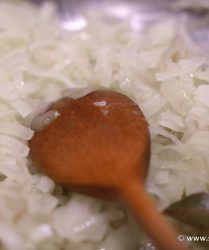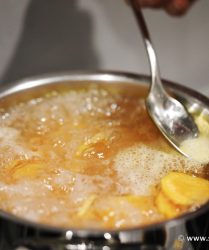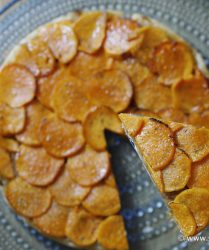The Cosmic Kitchen is
the fourth column from the series DISH!
I have many ways to find inspiration for creativity, but one of the most interesting ones is to create constraints or narrow the focus to something challenging. Finding a way to work with sweet potatoes is one such experience, since they have never been part of my culinary vocabulary. For a child growing up in Greece, more decades ago than I care to recount, this strange pod-like root looked and seemed alien in texture and flavour profile. This dish is one of these attempts at broadening my vocabulary and understanding of ingredients.
As always, the journey begins with choosing the right ingredients. For an appetizer or lunch for 4 people, pick 2-3 medium sized sweet potatoes, about 750gr in total. Look for smooth skin without blemishes, flesh that is firm to the touch, and roots that feel heavy and look even and mostly cylindrical. That latter characteristic will not improve their flavour, but it will do wonders for putting together a pretty dish on this occasion. Peel their skin and trim off any odd ends, keeping their overall shape as tidy as possible. With a sharp knife and steady resolve, or a mandolin if neither of those is at hand, slice your orange friends in 2mm-thick discs. Keep them in a bowl of cold water, for the time being, and get on with the task of peeling 400gr of large onions, a task made immeasurably more palatable with a glass of wine in close proximity. Cut the onions in half and slice in demilunes the thickness of the sweet potatoes (though a bit of irregularity here won’t hurt anyone).
Place a heavy pan on medium heat, melt two tablespoons of butter, and add the onion slices with a good pinch of salt. Over the next 30-40 minutes, with the occasional quick stir and splash of water, as needed, the onions will slowly cook down, soften, and sweeten. You don’t want them to caramelise or darken substantially, but to become mellow, rich, and sweet.
Take them off the heat, loosen with a tablespoon of water, if needed, and add a generous tablespoon of white miso paste, that blessing from Japan that is made by fermenting soy beans and which adds depth to a dish with great ease. Transfer to a plate and leave to cool down to room temperature.
While the onions are cooking, blanch your sweet potato slices in some boiling water, no more than a minute, or until they soften lightly and maintain their shape and integrity. Drain them gently and let them dry. In the meantime, pick a heavy-bottomed frying pan, about 35cm wide and brush it with two tablespoons of softened butter. On this, arrange a layer of potato slices in a pattern that makes you happy. This will eventually be at the top of your dish. Season with salt and continue layering and seasoning until you use all the remaining slices. You should have 3-4 layers, give or take. Spread the soft onions over the potatoes, in an even layer.
Pick your preferred method to get your hands on some puff pastry. If you enjoy making it, do so before the previous steps, so it has time to chill properly, but there is no shame in buying it readymade. Pick one made with real butter and your sins will be absolved. Roll it out to a circle roughly 40cm wide (or a few cm wider that the pan you chose) and a thickness of about 3mm. Place on top of the onion and tuck the edges into the pan and around the vegetables. Make a slit in the centre of the pastry disc and place the pan on medium heat for 10 minutes, before transferring to an oven preheated to 200°C, for about 20 minutes, or until the pastry is golden brown.
Place a large plate over the pan and with one swift movement overturn the pan and plate, until the tarte releases gently onto the plate. If a slice or two remain stubborn, persuade them with a spatula and no one will be the wiser. Sprinkle with some powdered bay leaf and serve in slices of whatever size you please.
TEXT TASSOS SARAMPALIS | PHOTOGRAPHY SANDER MARTENS
DISH is the brainchild of two friends, Sander Martens and Tassos Sarampalis. Though they come from very different parts of the world, they are both inspired by food; Sander as a photographer and Tassos as food writer. Together, they explore the taste and nature of food, visually, culturally, and artistically, influenced by their international and local experiences. The column is published every two months in Villa d’Arte (Kookkunst).
© Sander Martens & Tassos Sarampalis, all rights reserved












